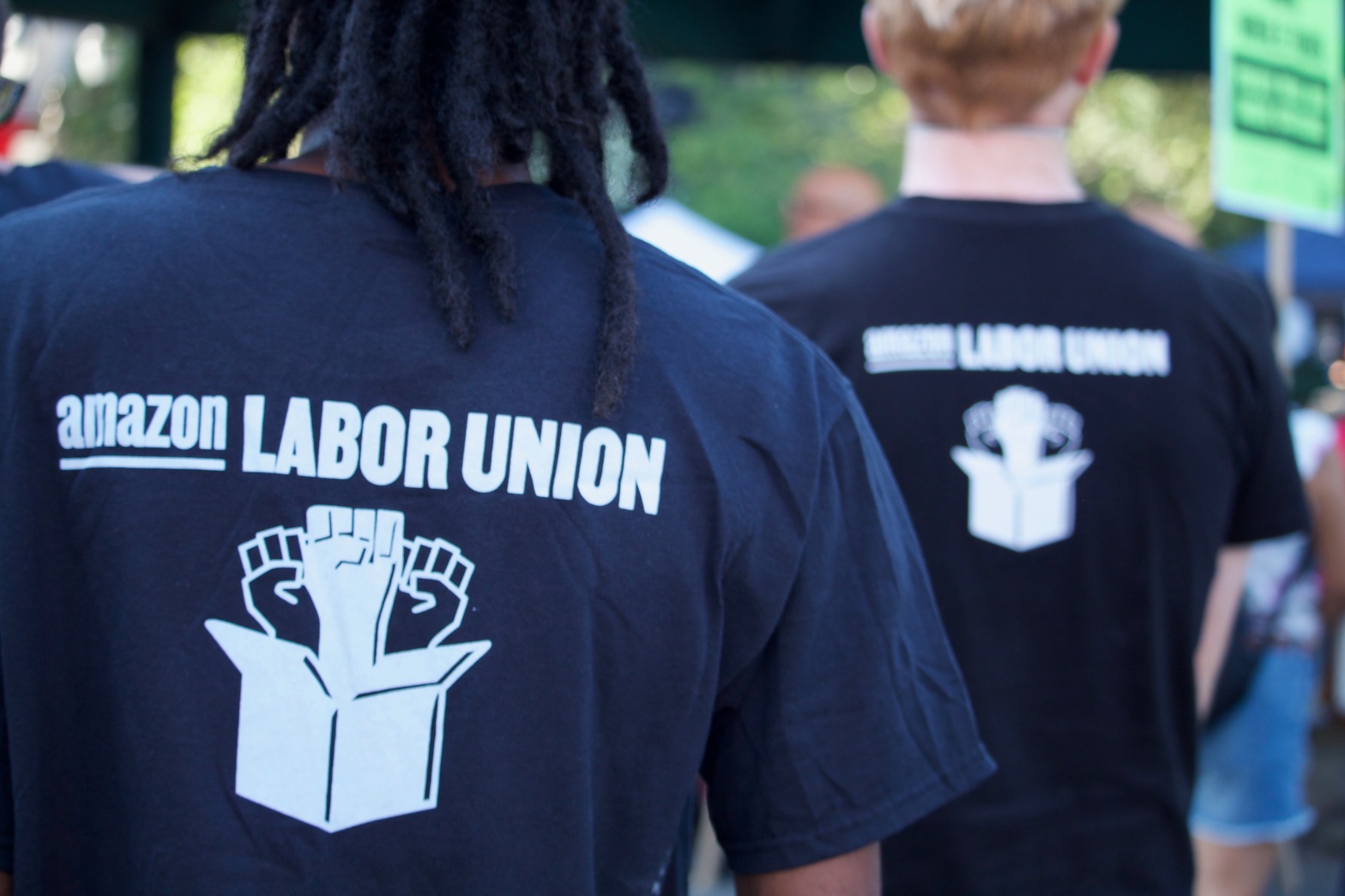By Nicholas Wurst (Sheet Metal, Air, Rail and Transportation Workers Local 1473) and Evren Pallares Ó Laoghaire (Teamsters Local 170)
A version of this article was originally published in the May issue of Socialism Today, available now! Subscribe here.
This year, there is something more to celebrate on International Workers Day, May 1st. A series of successful, high-profile union organizing campaigns by groups of workers at Amazon, Starbucks, and several universities around the country, are inspiring more workers to take action against corporate greed and workplace abuse.
On April 1st, the Amazon Labor Union (ALU) won its first election at the JFK8 Amazon warehouse in Staten Island, New York City. This victory for Amazon workers rocked the world, winning the first union in the U.S. at the capitalist giant. Other successful organizing, like the Starbucks Workers United campaign (SBWU), show the continued fighting mood that was demonstrated last fall during “Striketober”. The ALU and SBWU put out a joint statement calling for events on May 1st of this year to focus on fighting back against the vicious union busting, including at Amazon and Starbucks. A recent poll from A More Perfect Union shows that 75% of people support the ALU campaign. Mass support for this campaign from other unions and workers organizations could bring more workers into the broader labor movement.
The Amazon Labor Union was founded in April 2021 by a group of current and former Amazon workers and labor activists. Chris Smalls, who was fired from the Amazon JFK8 location in 2020, became the most visible leader and spokesperson for the ALU. This independent union successfully organized more than 8,000 workers at a large warehouse owned by one of the most powerful corporations in the world, despite the union being founded less than a year earlier. Established unions with more resources have failed to use their money and organizers to unionize Amazon over its 28 years in existence. Labor leaders in the AFL-CIO and other unions have failed, both from lack of trying and in outright defeats, to organize even one Amazon workplace in all that time.
Meanwhile, the attempt to organize an Amazon warehouse in Bessemer, AL with the Retail, Wholesale and Department Store Union (RWDSU) continues after the National Labor Relations Board (NLRB) ruled that Amazon interfered with the vote. This comes as no surprise when just last year, Amazon spent $4.3 million on anti-union consultants. The second vote is too close to call with 993 votes against unionizing, 875 for, and 416 contested. Amazon has filed legal challenges with the NLRB against the vote for the union in the JFK8 warehouse, and there are major obstacles for the ALU, including the fight for a first contract. Attacks on the union by management have already intensified, and the contract negotiations will be dragged out by the company to try and weaken the energy behind the union campaign.
Winning the union vote is just the first step; it takes an average of 409 days for unions to get first contracts, and 30% of unions never even get a first contract. However, the union has been contacted by Amazon workers at over 100 locations, not just across the U.S. but around the world as well, and has a strong potential base of members and supporters. Ballots are being counted right now for an ALU union election at a second Amazon plant. Given the massive expansion of Amazon, its abuse of workers, and the ever-growing pile of wealth controlled by the corporation, the ALU represents a way to start fighting back.
In a similar story, another massive corporation is being wracked by a blitz of unionization efforts. Starting late in 2021, Starbucks workers at over 200 locations across the country have filed for elections, with the first victory in December in Buffalo, NY. Over 40 stores nationwide have won union elections in just a few months (Washington Post 4/30/22). This effort is led by Workers United, an affiliate of the larger Service Employees International Union (SEIU). With hundreds more union elections already scheduled covering thousands of Starbucks workers, a major breakthrough in the long under-unionized fast food industry is in the works.
Signs of Life in the Labor Movement
There are other union battles that point towards a possible resurgence in the labor movement. The long-running strike of Teamsters Local 174 in Seattle which ended recently brought many important construction projects in the area to a halt. In a show of solidarity, and hopefully militancy, from the new reformer leadership of the Teamsters, the national Teamsters union donated $1 million to the Local’s strike fund. Warrior Met coal miners have been on strike for over a year. Teachers in Minneapolis, Chicago, and Puerto Rico have struck in past months. Hundreds of oil refinery workers at Chevron in California are now on strike. Numerous graduate students have recently unionized (like at MIT) or have won first contracts. After waiting more than two years for a contract, Columbia University graduate students went on strike and have now reached a tentative agreement with the university.
Upcoming contract negotiations include hundreds of thousands of workers in dozens of industries like grocery, healthcare, transportation, and logistics. These workers could take inspiration from the current mood and go on the offensive with strikes and other job actions. The International Brotherhood of Teamsters (IBT) elected the union-reform slate Teamsters United in the 2021 leadership election, including Sean O’Brien as the new General President. O’Brien has vowed to strike against UPS for a fair contract in 2023, which would be one of the biggest Teamster strikes in decades.
In the United Auto Workers (UAW), members won a referendum to directly elect union leadership and the first campaigns for leadership positions have been announced. The Teamsters Union adopted the same voting method at their 2021 convention. This is an important step forward for rebuilding the labor movement, and can help create openings for workers who want to campaign for leadership positions in the unions. The most effective unions are the most democratic. Union democracy strengthens union members and holds leadership accountable.
Urgent Fightback Needed
Record corporate profits ($2.81 trillion in 2021) and high inflation gives even more urgency in the fight back against corporate greed. The cost of living is rapidly increasing (read more in our article “Inflation Crisis Hurts Workers”), all as corporations siphon off more and more wealth. This is a feature of the capitalist system, as every cent of profit is squeezed from the labor of the working class and our wages. Socialists in the workers’ movement continue to fight for workers’ control of our workplaces, the economy, and the massive wealth that we produce. For over a hundred years, May 1st has been recognized by our movement as International Workers’ Day, a day to rally and fight for the most important demands of our class. From its beginning, International Workers’ Day was often used to agitate for union rights, the 8-hour day, higher wages, and benefits. Today, the working class also needs to fight against record low union membership, understaffing and overwork, stagnant wages, inflation, and corporate profiteering.
It’s crucial we learn from our past, including the last major wave of unionization in the 1930s-1950s which brought union rights to whole sectors of previously unorganized workers, as well as creating new industrial unions in the Congress of Industrial Organizations (CIO). Strikes and real mass organizing campaigns are desperately needed against union-busting tactics and anti-union laws. The Amazon Labor Union and Starbucks Workers United campaigns are two particularly important and inspiring struggles. But the labor movement needs to go beyond just attempting to organize one workplace at a time, or even one company at time, and instead become part of a fight to organize entire industries, including tackling the subcontracting most large corporations like Amazon use to try and stop workers forming unions. Unions need to use the majority of their resources for organizing, adopt more militant methods, and unite together to pool resources to take on large corporations.
Build a Workers’ Party
The PRO Act has been abandoned by the Democrats, like the Employee Free Choice Act (EFCA) was during the Obama administration. Many of the pro-labor elements of “Build Back Better” have been cut out of the various spending bills. Amazon and other corporations use their wealth to control U.S. politics and protect their profit-taking. It’s clear that the labor movement needs a political arm to fight against corporate power. While most unions have been in an abusive, one-sided relationship with the Democratic Party for decades, the birth of the ALU raises the question of a political alternative.
ALU’s first victory at JFK8 was not won by wasting time, money, and organizing resources supporting the Democratic Party. As a new union, the ALU was not tied down to the Democratic Party and its corporate politics and this gave the ALU a key advantage in union organizing. Union bureaucrats have chained the labor movement to the Democratic Party, a political party owned by big business. Despite voicing support, the Democratic Party politician and so-called “democratic socialist”, Representative Alexandria Ocasio-Cortez, never showed up at ALU rallies prior to the ALU victory. Chris Smalls initially called her out publicly for her lack of support, saying “they abandoned us,” referring to “progressive” Democrats. When asked at the victory rally about AOC, he said “She doesn’t deserve this moment.”
Without ties to the Democratic Party, the ALU could be in a position to help initiate the fight for independent, working-class political efforts, and could influence union activists and unions to throw off the chains of corporate politics. In addition to fighting on the shop floor, the ALU and other unions should organize union members to run as independents or help support other independent left candidates in order to challenge capitalist politics.
Unfortunately, since the unionization victory, the Democratic Party and its major figures, including AOC and Sanders, have worked overtime to co-opt the union. Most recent social media shows their efforts to lobby Smalls and the ALU are progressing, with Smalls now welcoming and celebrating AOC’s and Sanders’s recent visit to an ALU rally on Twitter, saying, “Solidarity is about accountability and second chances the only narrative that should matter is bringing people together.” The Democrats deserve no second chances from the working class, whom they have betrayed and misled for decades. The leadership and rank-and-file membership of the ALU must fight to maintain their independence from the Democratic Party.
The labor movement needs to initiate and be an important part of building a new workers’ party. In turn, a new workers’ party could help with mass union organizing and challenging anti-worker legislation. Unions must make a clear break from supporting both corporate parties by identifying union members—local, regional, and national—who can run for office and put forward a workers’ program as an alternative to the pro-boss agenda of the Democrats and Republicans. These efforts towards independent politics could strengthen existing union workplaces, make it easier to unionize new workplaces, and give unions more power in negotiating for contracts. The formation of a workers’ party could also allow union members from all sorts of different industries to discuss, debate, and unite together to build the labor movement.
Fight for Socialism
160 million + American workers represent explosive potential, not just to win higher wages and better jobs, but also to organize against racism, deadly climate change, and the massive inequality in U.S. society. A fighting labor movement armed with the traditions represented by the celebration of International Workers’ Day is key to building a much stronger labor movement as part of the struggle for international socialism.
Photo: Pamela Drew via Flickr

